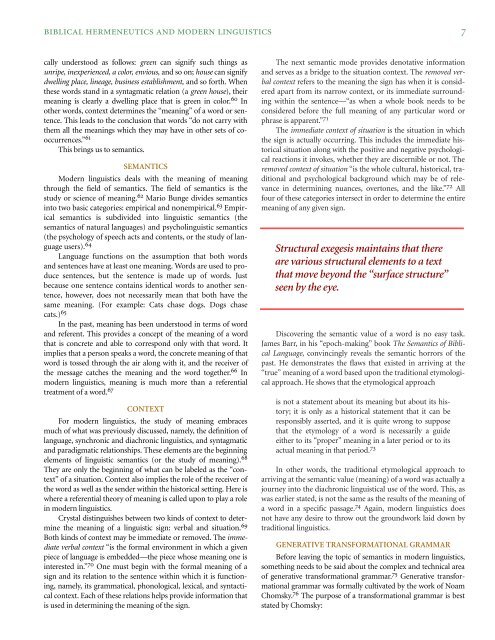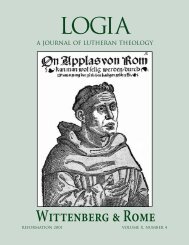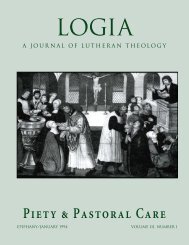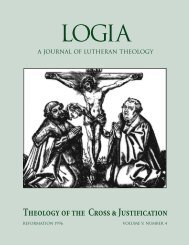04-2 Hermeneutics.pdf
04-2 Hermeneutics.pdf
04-2 Hermeneutics.pdf
- No tags were found...
Create successful ePaper yourself
Turn your PDF publications into a flip-book with our unique Google optimized e-Paper software.
BIBLICAL HERMENEUTICS AND MODERN LINGUISTICS 7cally understood as follows: green can signify such things asunripe, inexperienced, a color, envious, and so on; house can signifydwelling place, lineage, business establishment, and so forth. Whenthese words stand in a syntagmatic relation (a green house), theirmeaning is clearly a dwelling place that is green in color. 60 Inother words, context determines the “meaning” of a word or sentence.This leads to the conclusion that words “do not carry withthem all the meanings which they may have in other sets of cooccurrences.”61This brings us to semantics.SEMANTICSModern linguistics deals with the meaning of meaningthrough the field of semantics. The field of semantics is thestudy or science of meaning. 62 Mario Bunge divides semanticsinto two basic categories: empirical and nonempirical. 63 Empiricalsemantics is subdivided into linguistic semantics (thesemantics of natural languages) and psycholinguistic semantics(the psychology of speech acts and contents, or the study of languageusers). 64Language functions on the assumption that both wordsand sentences have at least one meaning. Words are used to producesentences, but the sentence is made up of words. Justbecause one sentence contains identical words to another sentence,however, does not necessarily mean that both have thesame meaning. (For example: Cats chase dogs. Dogs chasecats.) 65In the past, meaning has been understood in terms of wordand referent. This provides a concept of the meaning of a wordthat is concrete and able to correspond only with that word. Itimplies that a person speaks a word, the concrete meaning of thatword is tossed through the air along with it, and the receiver ofthe message catches the meaning and the word together. 66 Inmodern linguistics, meaning is much more than a referentialtreatment of a word. 67CONTEXTFor modern linguistics, the study of meaning embracesmuch of what was previously discussed, namely, the definition oflanguage, synchronic and diachronic linguistics, and syntagmaticand paradigmatic relationships. These elements are the beginningelements of linguistic semantics (or the study of meaning). 68They are only the beginning of what can be labeled as the “context”of a situation. Context also implies the role of the receiver ofthe word as well as the sender within the historical setting. Here iswhere a referential theory of meaning is called upon to play a rolein modern linguistics.Crystal distinguishes between two kinds of context to determinethe meaning of a linguistic sign: verbal and situation. 69Both kinds of context may be immediate or removed. The immediateverbal context “is the formal environment in which a givenpiece of language is embedded—the piece whose meaning one isinterested in.” 70 One must begin with the formal meaning of asign and its relation to the sentence within which it is functioning,namely, its grammatical, phonological, lexical, and syntacticalcontext. Each of these relations helps provide information thatis used in determining the meaning of the sign.The next semantic mode provides denotative informationand serves as a bridge to the situation context. The removed verbalcontext refers to the meaning the sign has when it is consideredapart from its narrow context, or its immediate surroundingwithin the sentence—“as when a whole book needs to beconsidered before the full meaning of any particular word orphrase is apparent.” 71The immediate context of situation is the situation in whichthe sign is actually occurring. This includes the immediate historicalsituation along with the positive and negative psychologicalreactions it invokes, whether they are discernible or not. Theremoved context of situation “is the whole cultural, historical, traditionaland psychological background which may be of relevancein determining nuances, overtones, and the like.” 72 Allfour of these categories intersect in order to determine the entiremeaning of any given sign.Structural exegesis maintains that thereare various structural elements to a textthat move beyond the “surface structure”seen by the eye.nbDiscovering the semantic value of a word is no easy task.James Barr, in his “epoch-making” book The Semantics of BiblicalLanguage, convincingly reveals the semantic horrors of thepast. He demonstrates the flaws that existed in arriving at the“true” meaning of a word based upon the traditional etymologicalapproach. He shows that the etymological approachis not a statement about its meaning but about its history;it is only as a historical statement that it can beresponsibly asserted, and it is quite wrong to supposethat the etymology of a word is necessarily a guideeither to its “proper” meaning in a later period or to itsactual meaning in that period. 73In other words, the traditional etymological approach toarriving at the semantic value (meaning) of a word was actually ajourney into the diachronic linguistical use of the word. This, aswas earlier stated, is not the same as the results of the meaning ofa word in a specific passage. 74 Again, modern linguistics doesnot have any desire to throw out the groundwork laid down bytraditional linguistics.GENERATIVE TRANSFORMATIONAL GRAMMARBefore leaving the topic of semantics in modern linguistics,something needs to be said about the complex and technical areaof generative transformational grammar. 75 Generative transformationalgrammar was formally cultivated by the work of NoamChomsky. 76 The purpose of a transformational grammar is beststated by Chomsky:
















